Four Dividend-paying Pharmaceutical Stocks to Buy for Income
By: Paul Dykewicz,
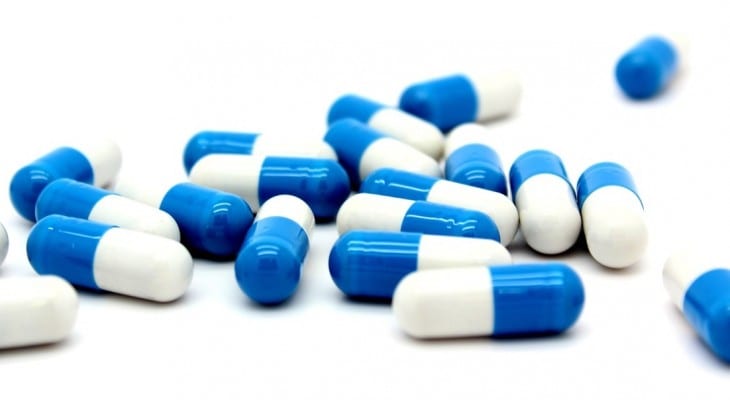
Four dividend-paying pharmaceutical stocks to buy for income provide protection from market plunges and Russia’s risk-filled war against Ukraine.
The four dividend-paying pharmaceutical stocks to buy feature U.S-based large-cap investments. Pharmaceutical stocks usually show resilience against inflation and market risk due to the continuing need for their products by the consumers who use need them.
Investors who want exposure to pharmaceuticals, including biopharmaceuticals, can choose from several ETFs, said Bob Carlson, who serves as chairman of a pension fund and also writes the Retirement Watch investment newsletter. Carlson chose two funds to highlight in addition to the four dividend-paying pharmaceutical stocks to buy for income.

Bob Carlson, head of Retirement Watch, talks to Paul Dykewicz.
ETF Shows Upward Trend Lifting Four Dividend-paying Pharmaceutical Stocks to Buy
First Trust Nasdaq Pharmaceuticals (FTXH) has earned higher returns over time compared to an alternative ETF, but it is the more volatile of the two choices, Carlson said. The fund generally holds smaller companies that are trading at lower valuations, compared to the portfolios of competing pharmaceutical ETFs, he added.
“As a result, the companies owned by the fund tend to have lower dividends and stock buybacks than others in the industry,” Carlson said.
In addition, FTXH is a concentrated fund. Recently, the ETF held 30 positions and had 58% of the fund in the 10 largest positions. The portfolio can change rapidly, with the ETF having a 77% turnover rate in the last year, Carlson counseled.
Top holdings recently were Merck & Co. (NYSE: MRK), Gilead Sciences (NASDAQ: GILD), Bristol-Meyers Squibb (NYSE: BMY), Johnson & Johnson (NYSE: JNJ) and Amgen (NASDAQ: AMGN). The fund had a 2.55% return in 2022.
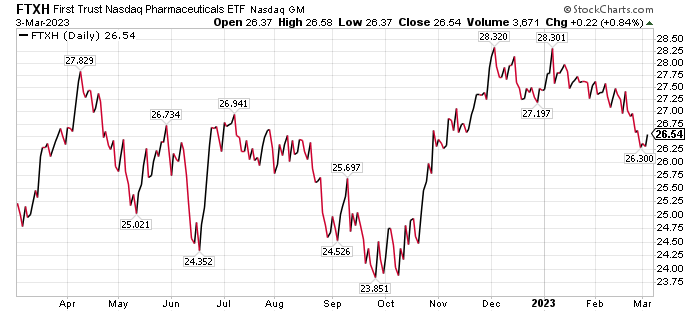
Chart courtesy of www.stockcharts.com
Four Dividend-paying Pharmaceutical Stocks to Buy Aside from Funds
A more conservative fund than FTXH is iShares U.S. Pharmaceuticals (IHE). The fund aims to track the Dow Jones U.S. Select Pharmaceuticals Index. Because it tries to mirror an index, IHE has a lower turnover ratio of only 20% compared to FTXH.
IHE recently had 48 positions and 74% of its portfolio was composed of its 10 largest positions. Top holdings were Johnson & Johnson (NYSE: JNJ), Eli Lilly (NYSE: LLY), Catalent (NYSE: CTLT), Zoetis (NYSE:ZTS) and Viatris (NASDAQ: VTRS).
The fund declined 4.87% in 2022. It is down so far this year but expected to rise again by year-end.
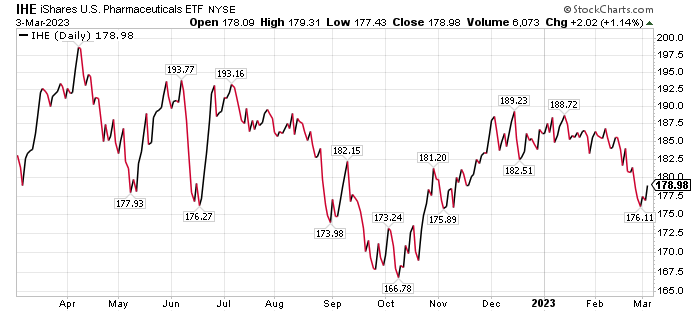
Chart courtesy of www.stockcharts.com
Pfizer Omitted from Four Dividend-paying Pharmaceutical Stocks to Buy
New York-based Pfizer Inc. (NYSE: PFE) proved to be a strong, dividend-paying investment from December 2015 to July 2021 when Mark Skousen, PhD, recommended it in his Forecasts and Strategies investment newsletter. The stock rose 54.76% during that pandemic-afflicted time.
One of the first pharmaceutical companies to have its COVID-19 vaccine approved, Pfizer’s share price rose during the pandemic. However, Skousen, who also leads the Five Star Trader advisory service that features stocks and options, spotted weakness in the stock and the market when he recommended taking profits.

Mark Skousen, a scion of Ben Franklin and head of Five Star Trader, meets Paul Dykewicz.
The strategy paid off and he has not returned to recommending the stock since then. A panel of outside advisers to the U.S. Food and Drug Administration recommended Pfizer’s respiratory syncytial virus (RSV) vaccine on Feb. 28 to advance it toward approval to become one of the initial approved injections for older adults in the United States. However, the 7-4 advisory committee vote was not overwhelming, and one panelist abstained. The majority of the experts concluded the shot was effective and safe in preventing lower respiratory tract disease caused by RSV in people 60 years old and up.
Four Dividend-paying Pharmaceutical Stocks to Buy Include Bristol Myers Squibb
New York-based Bristol Myers Squibb is a large-cap pharmaceutical stock recommended by BofA Global Research. The investment bank gave the stock a price target of $80.
The valuation used a 50/50 blended average of BofA’s risk-adjusted Discounted Cash Flow Analysis and price-to-earnings multiple applied to 2023 earnings per share (EPS). A 10x multiple is warranted, compared with 18x the pharmaceutical industry average, equaling a near-term growth profile and discounted for an “impending patent cliff” already priced in by the market, BofA added.
BMY shares outperformed in 2022, rising 15% compared to a 20% decline in the S&P 500. The market beat stemmed from commercial and pipeline progress, as well as a shift in investor sentiment to defensive names in Biopharmaceuticals, BofA wrote.
“In our view, Bristol should get credit for launching three first-in-class products in 2022, including Opdualag, Camzyos and Sotyktu, marking a total of nine new launches since 2019,” BofA wrote in a recent research note.
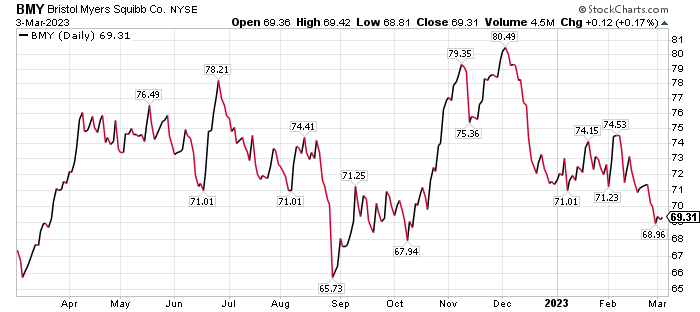
Chart courtesy of www.stockcharts.com
Eli Lilly Joins Four Dividend-paying Pharmaceutical Stocks to Buy
Indianapolis-based Eli Lilly is another BofA recommendation among large-cap pharmaceutical stocks. The investment firm gave it a $390 price objective.
Lilly’s gains remain “differentiated” with a 2022-25 compound annual growth rate (CAGR) of 13% in revenue and 26% in earnings per share (EPS), while its peer stocks incurred a 1% dip in revenue and a 4% gain in EPS during the same period, BofA wrote. The outperformance is due mainly to a robust new product cycle that makes LLY shares a core growth holding for certain investors.
Given the complexities of five new launches in the near-term, featuring donanemab, pirtobrutinib, mirikizumab, lebrikizumab and tirzepatide in obesity, BofA wrote that it expects Lilly’s strategy of focusing on pipeline and commercial execution to pay off. The effort is supported by meaningful increases in research and development (R&D) and selling, general and administrative (SG&A) expenses. As of 2027, these products are expected to make up more than 20% of the company’s revenue forecast.
To account for a $390 price objective, BofA uses a sum-of-the parts net present value (NPV) analysis. The investment bank values its endocrinology franchise at $212 per share, oncology at $87 per share, cardiovascular at $5 per share, neuroscience at $23 per share, immunology at $20 share, its product pipeline at $54 per share and its net cash position at -$12 per share.
Lilly gained some favorable publicity this week by announcing price cuts that would slash the amount consumers pay for the most commonly used forms of its insulin by 70%. Company officials said on March 1 that Lilly will cap out-of-pocket insulin costs at $35 for people who have private insurance and use participating pharmacies.
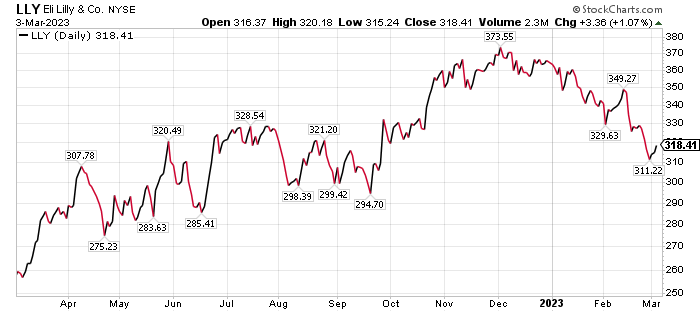
Chart courtesy of www.stockcharts.com
Merck Makes List of Four Dividend-paying Four Pharmaceutical Investments to Buy
Merck, of Rahway, New Jersey, had the best 2022 performance of all U.S. pharmaceuticals, BofA wrote in a research note. The beat was driven by strong commercial performance from the core business, i.e., Keytruda and Gardasil, BofA added.
“Looking to 2023, we are optimistic that Merck’s strong commercial execution could drive continued revenue growth of $58.5 billion vs. $58.0 billion consensus, +7% year over year growth, excluding Lagevrio,” BofA wrote. “We have upgraded to Buy from Neutral with a $130 price objective.”
That marks a $20 jump in BofA’s previous price objective. Even though Merck’s business faces a “no growth” outlook in 2023, it is not a reason to avoid the stock at the right price.
That is the view expressed by Michelle Connell, who heads Dallas-based Portia Capital Management.

Michelle Connell leads Dallas-based Portia Capital Management.
Connell Praises One of Four Dividend-paying Pharmaceutical Stocks to Buy
“The company’s stock has appreciated more than 50% in the last 12 months,” Connell said. “However, based on the following information, it would make sense to dollar-cost average for potential capital appreciation and the current dividend.”
However, Merck’s management team always has been “smart” in how much it wants to invest in R&D and in its “bright and multi-faceted future,” Connell continued. Merck has invested in its future through large allocations to R&D, she added.
In both 2021 and 2022, the company allocated more than 20% of its gross revenues to R&D. This investment has resulted in the strongest oncology pipeline in the pharmaceutical industry, Connell commented.
This pipeline will let the company replace its dependence on Keytruda and Gardasil, both of which have patents expiring in 2028, Connell told me.
Merck generated more than $14 billion of free cash flow from its operations last year. This large amount of cash will allow the company to not only keep funding its R&D, continue paying out a healthy dividend, but keep scouting for acquisitions that make sense and can complement the pharmaceuticals coming up through its current pipeline.
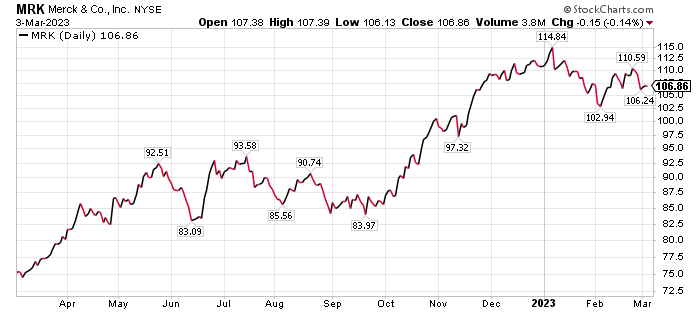
Chart courtesy of www.stockcharts.com
JNJ Joins Four Dividend-paying Pharmaceutical Stocks to Buy
The fourth dividend-paying pharmaceutical stock to buy is Johnson & Johnson (NYSE: JNJ), of New Brunswick, N.J. Bryan Perry, a seasoned Wall Street trader, has recommended JNJ call options in his Breakout Options Alert advisory service.

Bryan Perry leads the Breakout Options Alert service.
The U.S. dollar endured a meaningful decline during the fourth quarter, which is a huge positive signal for U.S. multinational companies. For companies in essential sectors, such as health care and pharmaceuticals, Perry opined that they will not only post strong fourth-quarter results but also will guide higher nearing the end of the current first quarter.
JNJ is a trusted Dow Jones component that traded up to $180 in mid-January before pulling back in favor of money that was rotating to the big-cap growth stocks. At its current price below $155, the pullback is attractive and constructive for the stock to forge higher sooner or later.
The chart of JNJ shows a steep pullback that should be followed by a strong move higher, said Perry, who also heads the Cash Machine investment newsletter. With the stock pulling back since the start of 2023, it realistically could rebound in the months ahead and provide for a high-return/low-risk trade, he added.
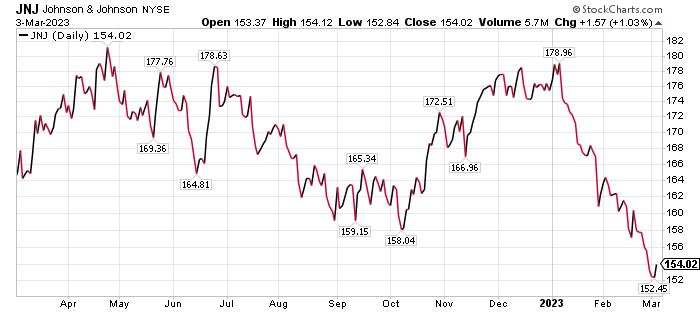
Chart courtesy of www.stockcharts.com
Micro-Cap Pharmaceutical Stocks Offer Alternative Way to Invest
Another way to invest in biopharmaceuticals is through micro-cap stocks. That is the niche of futurist George Gilder’s Moonshots advisory service, which intentionally limits its circulation to enhance its exclusivity. The Moonshots track record has been shining as an outperforming advisory service that may have a new pharmaceutical pick soon after Gilder and Senior Analyst Richard Vigilante just returned from Israel to conduct due diligence on potential investments.
My column next week will feature mid-cap pharmaceutical stocks, but investors interested in micro-cap alternatives may want to know Moonshots’ portfolio companies jumped an average of 84%, double the gains of the NASDAQ, from July 2019 to February 2023, counting only closed positions. I am trying to obtain direct input from Gilder and his team next week as they seek out companies developing the kinds of new paradigms that investors crave.
Russia Troops Pound Bakmut in Eastern Ukraine, But Incur Drone Strikes
Russian forces keep pounding Bakhmut in eastern Ukraine, but the city still is not surrounded, Ukrainian officials said. Civilians there reportedly number in the thousands and are mostly cut off from humanitarian relief.
However, drone strikes hit targets on Russian soil on Feb. 28. President Vladimir Putin ordered tightened control of the Ukraine border after a flurry of drone attacks hit regions inside Russia, include one just 60 miles from Moscow.
Russia has absorbed more combat deaths in Ukraine during its first year of war than in all its wars combined since the end of World War II, according to new research from the Center for Strategic and International Studies (CSIS). The average number of Russian troops killed per month is 25 times the number killed per month in Chechnya and 35 times those killed in Afghanistan.
The death toll for Russian soldiers shows the high casualty rate of a war of attrition that Russia seems to be pursuing as it sends waves of troops to front lines to sustain its invasion of Ukraine to seize land that the United Nations describes as a blatant violation of international law.
“The Ukrainian military has also performed remarkably well against a much larger and initially better-equipped Russian military, in part due to the innovation of its forces,” the CSIS wrote.
FBI Director Says COVID-19 Probably Escaped from Lab in China
FBI Director Christopher Wray left little room for doubt when he spoke Tuesday, Feb. 28, saying that COVID-19 likely leaked out of a laboratory in China. It marked the first public opinion of that kind from the FBI about the origins of the virus that caused a global pandemic.
“The FBI has for quite some time now assessed that the origins of the pandemic are most likely a potential lab incident in Wuhan,” Wray told Fox News. “Here you are talking about a potential leak from a Chinese government-controlled lab.”
Worldwide COVID-19 deaths rose to 6,871,652 people, with total cases of 675,299,609, Johns Hopkins reported on March 1. COVID-19 cases in the United States totaled 103,420,826, while deaths reached 1,119,885 as of March 1, according to Johns Hopkins University. Until recent reports that China had more than 248 million cases of COVID-19, America had ranked as the nation with the most coronavirus cases and deaths.
The U.S. Centers for Disease Control and Prevention reported that 269,554,116 people, or 81.2% of the U.S. population, have received at least one dose of a COVID-19 vaccine, as of March 1. People who have completed the primary COVID-19 doses totaled 230,075,934 of the U.S. population, or 69.3%, according to the CDC. The United States has given a bivalent COVID-19 booster to 50,544,428 people who are age 18 and up, equaling 19.6% as of March 1.
The four dividend-paying pharmaceutical stocks to buy as protection should hold up better than the overall market, as occurred in 2022. Pharmaceutical investments may offer an elixir for investors seeking exposure to an industry that analysts expect to recover later this year.







 Connect with Paul Dykewicz
Connect with Paul Dykewicz




